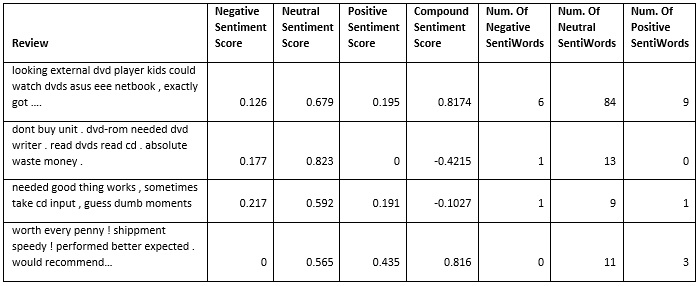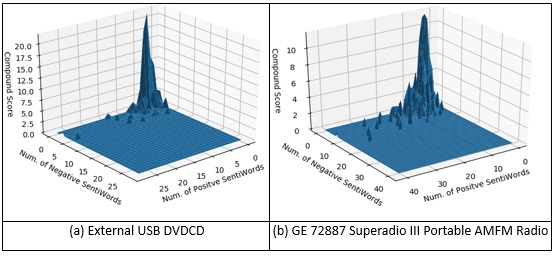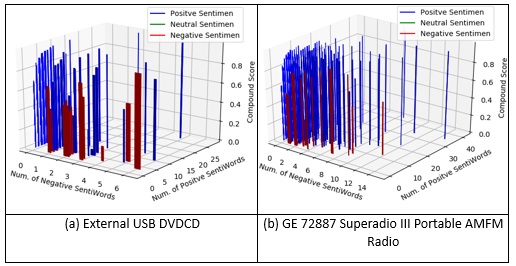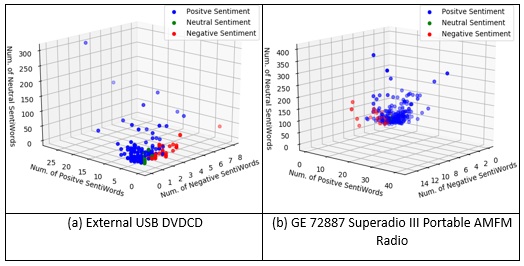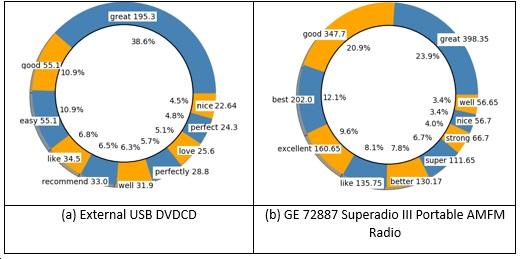E-commerce has become more popular with the growth in internet and network technologies. Many people feel convenient to buy products online using various forums such as Amazon, Flipchart, Awok etc. When customers buy the products online there is an option for them to provide their review comments. Many customers chose to provide their experience, opinion, feedback etc. Such product reviews are rich in information consisting of feedback shared by users. The review comments are useful to both other buyers and vendors. The sentiment analysis of customer reviews helps the vendor to understand user’s perspectives. They can further use the review comments and improve their products.
Figure 1. Sentiment analysis of customer review comments
The sentiment analyzer such as VADER provides the sentiment score in terms of positive, negative, neutral and compound score as shown in figure 1. Amazon is an e-commerce site and many users provide review comments on this online site. This research focuses on sentiment analysis of Amazon customer reviews. The analysis is carried out on 12,500 review comments. The preprocessing of reviews is performed first by removing URL, tags, stop words, and letters are converted to lower case letters. On each comment, the VADER sentiment analyzer is performed. The following table shows examples of review comments and sentiment scores computed by VADER. Also, the number of positive, negative, neutral sentiment words are tabulated.
3D Sentiment Visualization
Review comments on a few specific items are selected, and sentiment analysis is performed on these comments. The review comments for external USB DVDCD and GE 72887 Superadio III Portable AMFM Radio are analyzed. There are 199 comments for external USB DVDCD and 11,630 words. For GE 72887 Superadio III Portable AMFM Radio, 265 comments, and 33,973 words. For a given review, each word contributes to the overall sentiment and it is interesting to know the contribution of the number of sentiment words to the score. The contribution of positive and negative words to the compound score is depicted in terms of the 3D surface in figure 2.
Figure 2. 3D surface view of compound sentiment score.
In figure 2(a) the compound score for review comments of external USD DVDCD as the 3D surface against the number of positive and negative words is shown. This 3D surface reveals the variation in the compound score for a particular item due to the number of positive and negative words.
In figure 3, the 3D column chart is depicted for external USB DVDCD and GE 72887 Superadio III Portable AMFM Radio. The compound score for the reviews is plotted as column chart against the number of positive words along the x-axis and number of negative words along the y-axis. Using this 3D column chart the characteristics of product reviews can be understood.
Figure 3. 3D column chart for compound sentiment score
A review comment can be considered as a point in 3D space with coordinates as the number of positive, number negative and the number of neutral words. This results in 3D space scatter plot of review comments. In figure 4 the 3D scatter plot for external USB DVDCD and GE 72887 Superadio III Portable AMFM Radio are shown. Each review is a point in this 3D space also given the color of Blue for positive, Red for negative and Green for neutral compound sentiment score. This 3D scatter plot represents the distribution of review scores against the number of sentiment words.
Figure 4. 3D scatter plot for customer reviews.
The words having maximum sentiment score and minimum sentiment score can be collected for each product. The following pie chart in figure 5 shows the ten words with maximum positive sentiment score for external USB DVDCD and GE 72887 Superadio III Portable AMFM Radio. These are words which customers have written in product reviews. The pie chart represents the most praised part of the products by customers. Similarly, most common words with negative sentiments will represent in review comments help vendors to improve their products.
Figure 5. Pie chart for top ten words.
Research Paper
The research on sentiment visualization of Amazon reviews is appeared in:
http://thesai.org/Publications/ViewPaper?Volume=9&Issue=5&C…
Cite the Work
Please cite the following research paper:
Siddhaling Urologin, Sunil Thomas, “3D Visualization of Sentiment Measures and Sentiment Classification using Combined Classifier for Customer Product Reviews”, International Journal of Advanced Computer Science and Applications (IJACSA), Volume 9 Issue 5, pp. 60-68, June 2018.
Further Projects and Contact
For further reading and other projects please visit
Dr. Siddhaling Urolagin,
Department of Computer Science
BITS Pilani, Dubai Campus, Academic City
Dubai, United Arab Emirates

